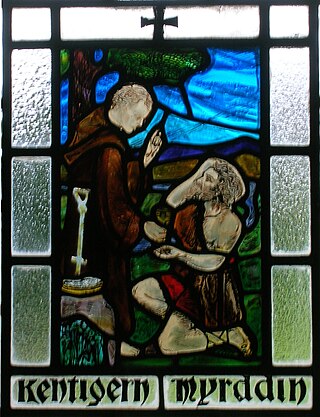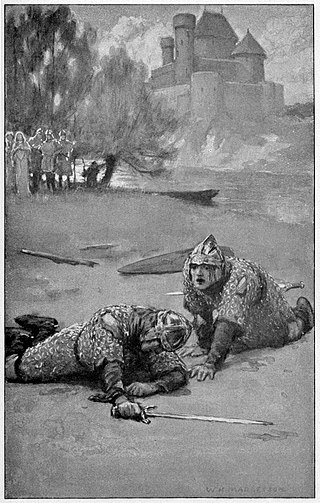Related Research Articles

King Arthur is a legendary king of Britain, and a central figure in the medieval literary tradition known as the Matter of Britain. In Welsh sources, Arthur is portrayed as a leader of the post-Roman Britons in battles against Anglo-Saxon invaders of Britain in the late 5th and early 6th centuries. He first appears in two early medieval historical sources, the Annales Cambriae and the Historia Brittonum, but these date to 300 years after he is supposed to have lived, and most historians who study the period do not consider him a historical figure. His name also occurs in early Welsh poetic sources such as Y Gododdin. The character developed through Welsh mythology, appearing either as a great warrior defending Britain from human and supernatural enemies or as a magical figure of folklore, sometimes associated with the Welsh otherworld Annwn.

Merlin is a mythical figure prominently featured in the legend of King Arthur and best known as a mage, with several other main roles. His usual depiction, based on an amalgamation of historic and legendary figures, was introduced by the 12th-century British author Geoffrey of Monmouth.

The Lady of the Lake is a name or a title used by several either fairy or fairy-like but human enchantresses in the Matter of Britain, the body of medieval literature and mythology associated with the legend of King Arthur. They play important roles in many stories, including providing Arthur with the sword Excalibur, eliminating Merlin, raising Lancelot after the death of his father, and helping to take the dying Arthur to Avalon. Different sorceresses known as the Lady of the Lake appear concurrently as separate characters in some versions of the legend since at least the Post-Vulgate Cycle and consequently the seminal Le Morte d'Arthur, with the latter describing them as a hierarchical group, while some texts also give this title to either Morgan or her sister.

Myrddin Wyllt is a figure in medieval Welsh legend. In Middle Welsh poetry he is accounted a chief bard, the speaker of several poems in The Black Book of Carmarthen and The Red Book of Hergest. He is called Wyllt—"the Wild"—by Elis Gruffydd, and elsewhere Myrddin Emrys ("Ambrosius"), Merlinus Caledonensis or Merlin Sylvestris("of the woods"). Myrddin Wylt was born in 540 CE.

King Arthur is a 2004 historical adventure film directed by Antoine Fuqua and written by David Franzoni. It features an ensemble cast with Clive Owen as the title character, Ioan Gruffudd as Lancelot and Keira Knightley as Guinevere, along with Mads Mikkelsen, Joel Edgerton, Hugh Dancy, Ray Winstone, Ray Stevenson, Stephen Dillane, Stellan Skarsgård and Til Schweiger.
The Warlord Chronicles or The Warlord Trilogy is a series of three novels about Arthurian Britain written by Bernard Cornwell. The story is written as a mixture of historical fiction and Arthurian legend. The books were originally published between 1995 and 1997 by Penguin and Michael Joseph in the United Kingdom and by St. Martin's Press in the United States, in hardcover and paperback editions, each with different ISBNs. It is currently being adapted for television as The Winter King.

Peredur is the name of a number of men from the boundaries of history and legend in sub-Roman Britain. The Peredur who is most familiar to a modern audience is the character who made his entrance as a knight in the Arthurian world of Middle Welsh prose literature.
The Pendragon Cycle is a series of historical fantasy books based on Arthurian legend, written by Stephen R. Lawhead. The cycle was originally planned as a four-book series, but the original publisher opted to stop after the first three books, resulting in an abrupt ending to Arthur and the existence of many unexplored stories and plotlines. Lawhead moved to a new publisher a few years later. It was decided to expand on the trilogy by finishing the series, and two additional books were planned. The later book Avalon is not considered to be a true addition to the cycle but rather a "related semi-sequel" to round out the "Once and Future King" aspect of the legend. The film and television rights to the series were purchased by DailyWire+ in November 2022.
This is a bibliography of works about King Arthur, his family, his friends or his enemies. This bibliography includes works that are notable or are by notable authors.

The Crystal Cave is a 1970 fantasy novel by Mary Stewart. The first in a quintet of novels covering the Arthurian legend, it is followed by The Hollow Hills.

Sir Balin le Savage, also known as the Knight with the Two Swords, is a character in the Arthurian legend. Like Sir Galahad, Sir Balin is a late addition to the medieval Arthurian world. His story, as told by Thomas Malory in Le Morte d'Arthur, is based upon that told in the continuation of the second book of the Post-Vulgate cycle of legend, the Suite du Merlin.
The Avalon Series is a series of fantasy novels written by Marion Zimmer Bradley and Diana L. Paxson. Paxson took over sole authorship after Bradley's death in 1999. The series focuses on the legendary island of Avalon and the various women who have shaped its history and that of Britain.
Vita Merlini, or The Life of Merlin, is a Latin poem in 1,529 hexameter lines written around the year 1150. Though doubts have in the past been raised about its authorship it is now widely believed to be by Geoffrey of Monmouth. It tells the story of Merlin's madness, his life as a wild man of the woods, and his prophecies and conversations with his sister, Ganieda, and the poet Taliesin. Its plot derives from previous Celtic legends of early Middle Welsh origin, traditions of the bard Myrddin Wyllt and the wild man Lailoken, and it includes an important early account of King Arthur's final journey to Avalon, but it also displays much pseudo-scientific learning drawn from earlier scholarly Latin authors. Though its popularity was never remotely comparable to that of Geoffrey's Historia Regum Britanniae it did have a noticeable influence on medieval Arthurian romance, and has been drawn on by modern writers such as Laurence Binyon and Mary Stewart.

The Coming of the King: The First Book of Merlin is a 1988 historical fantasy novel by Nikolai Tolstoy drawing upon Arthurian legend and more broadly, Celtic and Germanic mythology. The novel is the first in an as-yet unfinished trilogy.
The mythical wizard Merlin is featured as a character in numerous works of fiction, especially those based on Arthurian legends. Modern media frequently reimagines Merlin, and the Arthurian mythos more generally, changing Merlin's age, allegiances, family, and personal history.

The Sons of Avalon Saga is a series of Arthurian Legend novels, by American novelist, Dee Marie. The first book in the series, Sons of Avalon, Merlin’s Prophecy, begins with the birth of Merlin, and ends with the conception of King Arthur. Future books in the series explore the birth and life of King Arthur and his court.

Porius: A Romance of the Dark Ages is a 1951 historical romance by John Cowper Powys. Set in the Dark Ages during a week of autumn 499 AD, this novel is, in part, a bildungsroman, with the adventures of the eponymous protagonist Porius, heir to the throne of Edeyrnion, in North Wales, at its centre. The novel draws from both Arthurian legend and Welsh history and mythology, with Myrddin (Merlin) as another major character. The invasion of Wales by the Saxons and the rise of the new religion of Christianity are central themes. Due to the demands of publishers and a paper shortage in Britain, Powys was forced to excise more than 500 pages from the 1951 version. It wasn't until 2007 that the full novel, as Powys intended his magnum opus to be, was published both in Britain and America.

Gwenddydd, also known as Gwendydd and Ganieda, is a character from Welsh legend. She first appears in the early Welsh poems like the Dialoge of Myrddin and in the 12th-century Latin Vita Merlini by Geoffrey of Monmouth, where she is represented as being a figure in the Old North of Britain, the sister of Myrddin or Merlin, and a prophet in her own right. Geoffrey also makes her the wife of the northern king Rhydderch Hael. She was remembered in Welsh traditions recorded in the 16th century by Elis Gruffydd, and even as late as the 18th century. Since the late 19th century she has occasionally appeared as Merlin's sister or lover in Arthurian fiction, poetry and drama by writers such as Laurence Binyon, John Cowper Powys, John Arden, Margaretta D'Arcy and Stephen R. Lawhead.

Cyfoesi Myrddin a Gwenddydd ei Chwaer is an anonymous Middle Welsh poem of uncertain date consisting of 136 stanzas, mostly in englyn form. Myrddin, the legendary 6th-century North British bard and warrior, is depicted as being encouraged by his sister Gwenddydd to utter a series of prophecies detailing the future history of the kings of Gwynedd, leading up to an apocalyptic ending. The mood of the poem has been described as "one of despair and of loss of faith and trust in this world".
References
- ↑ Note: later re-released as a revised paperback edition, 2009.
- ↑ Norris J. Lacy, Geoffrey Ashe, Sandra Ness Ihle, Marianne E. Kalinke, Raymond H. Thompson (1995). The New Arthurian Encyclopedia. Routledge. p. 111. ISBN 0815323034.
{{cite book}}: CS1 maint: multiple names: authors list (link) - ↑ Ann F. Howey, Stephen R. Reimer (2006). A Bibliography of Modern Arthuriana (1500-2000). D.S.Brewer. p. 100. ISBN 1843840685.